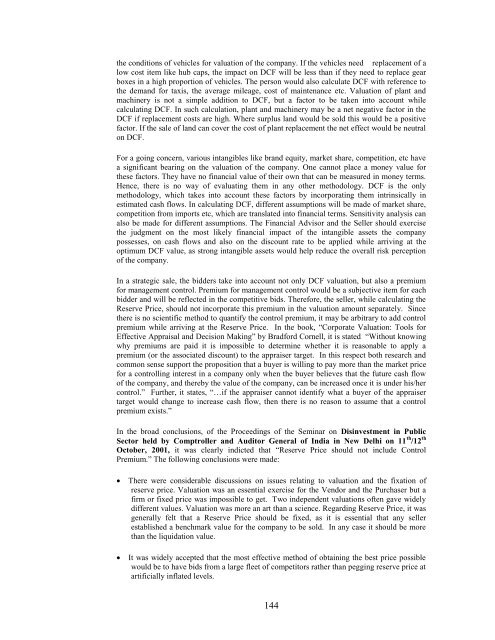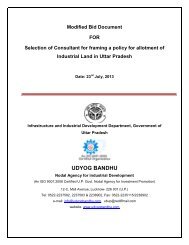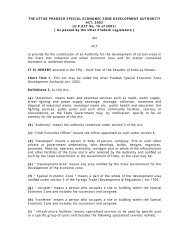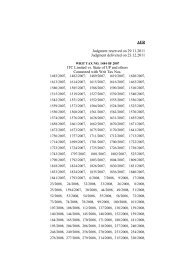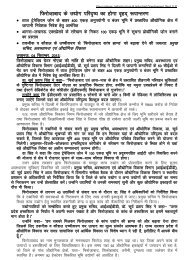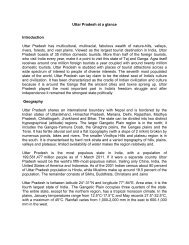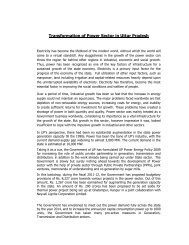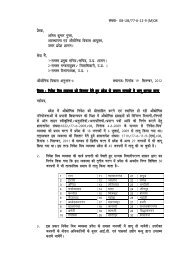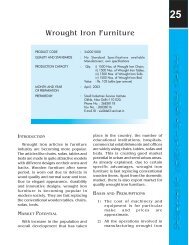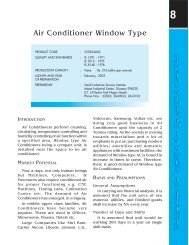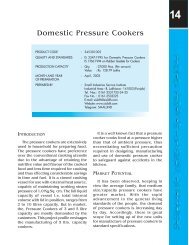PART - III - Udyog Bandhu
PART - III - Udyog Bandhu
PART - III - Udyog Bandhu
You also want an ePaper? Increase the reach of your titles
YUMPU automatically turns print PDFs into web optimized ePapers that Google loves.
the conditions of vehicles for valuation of the company. If the vehicles need replacement of alow cost item like hub caps, the impact on DCF will be less than if they need to replace gearboxes in a high proportion of vehicles. The person would also calculate DCF with reference tothe demand for taxis, the average mileage, cost of maintenance etc. Valuation of plant andmachinery is not a simple addition to DCF, but a factor to be taken into account whilecalculating DCF. In such calculation, plant and machinery may be a net negative factor in theDCF if replacement costs are high. Where surplus land would be sold this would be a positivefactor. If the sale of land can cover the cost of plant replacement the net effect would be neutralon DCF.For a going concern, various intangibles like brand equity, market share, competition, etc havea significant bearing on the valuation of the company. One cannot place a money value forthese factors. They have no financial value of their own that can be measured in money terms.Hence, there is no way of evaluating them in any other methodology. DCF is the onlymethodology, which takes into account these factors by incorporating them intrinsically inestimated cash flows. In calculating DCF, different assumptions will be made of market share,competition from imports etc, which are translated into financial terms. Sensitivity analysis canalso be made for different assumptions. The Financial Advisor and the Seller should exercisethe judgment on the most likely financial impact of the intangible assets the companypossesses, on cash flows and also on the discount rate to be applied while arriving at theoptimum DCF value, as strong intangible assets would help reduce the overall risk perceptionof the company.In a strategic sale, the bidders take into account not only DCF valuation, but also a premiumfor management control. Premium for management control would be a subjective item for eachbidder and will be reflected in the competitive bids. Therefore, the seller, while calculating theReserve Price, should not incorporate this premium in the valuation amount separately. Sincethere is no scientific method to quantify the control premium, it may be arbitrary to add controlpremium while arriving at the Reserve Price. In the book, “Corporate Valuation: Tools forEffective Appraisal and Decision Making” by Bradford Cornell, it is stated “Without knowingwhy premiums are paid it is impossible to determine whether it is reasonable to apply apremium (or the associated discount) to the appraiser target. In this respect both research andcommon sense support the proposition that a buyer is willing to pay more than the market pricefor a controlling interest in a company only when the buyer believes that the future cash flowof the company, and thereby the value of the company, can be increased once it is under his/hercontrol.” Further, it states, “…if the appraiser cannot identify what a buyer of the appraisertarget would change to increase cash flow, then there is no reason to assume that a controlpremium exists.”In the broad conclusions, of the Proceedings of the Seminar on Disinvestment in PublicSector held by Comptroller and Auditor General of India in New Delhi on 11 th /12 thOctober, 2001, it was clearly indicted that “Reserve Price should not include ControlPremium.” The following conclusions were made:There were considerable discussions on issues relating to valuation and the fixation ofreserve price. Valuation was an essential exercise for the Vendor and the Purchaser but afirm or fixed price was impossible to get. Two independent valuations often gave widelydifferent values. Valuation was more an art than a science. Regarding Reserve Price, it wasgenerally felt that a Reserve Price should be fixed, as it is essential that any sellerestablished a benchmark value for the company to be sold. In any case it should be morethan the liquidation value.It was widely accepted that the most effective method of obtaining the best price possiblewould be to have bids from a large fleet of competitors rather than pegging reserve price atartificially inflated levels.144


